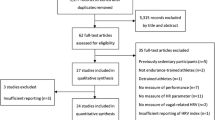Abstract
Purpose
The practice of judo is associated with some heart conditions. Some authors suggest cardiac morphometric changes as an increase in diastolic dimension of the left ventricle, interventricular septum and posterior wall thickness of the left ventricle with an improvement in aerobic and anaerobic performance. However, few studies have explored the autonomic modulation by heart rate variability in judo athletes. The objective of this study was to evaluate the effect of judo training 6 months on autonomic modulation analysis, time and frequency domains symbolic.
Methods
The study included 16 young male, 18–25 years of age were recruited from university students through campus ads and divided into two groups: sedentary young males (S; n = 9) and judo (n = 7).
Results
There are no significant differences in age, height, weight, body mass index and heart rate among sedentary groups and judo. During the reporting period, sedentary individuals displayed parameters of the variability of the lower heart rate in the time domain, as SDNN, RMSSD, PNN50 and VarRR, compared with the subjects of judo. As the symbolic analysis it observed greater parasympathetic modulation (2UV) in judo group, compared with the sedentary group. However, no changes were observed in the sympathetic modulation (0V) between the groups.
Conclusions
We conclude that the exclusive practice of judo for 6 months produces autonomic changes, even without contributing to changes in body composition.


Similar content being viewed by others
References
Bu B et al (2010) Effects of martial arts on health status: a systematic review. J Evid Based Med 3(4):205–219
Franchini E et al (2011) Physiological profiles of elite judo athletes. Sports Med 41(2):147–166
Cortell Tormo JM, Pérez Turpin JA, Lucas Cuevas AG, Pérez Soriano P, Llana Belloch S, Martinez-Patiño MJ (2013) Handgrip strength and hand dimensions in high-level inter-university judoists. Arch Budo 9(1):21–28
Smaruj RLM (2008) Changes in anaerobic capacity influenced by during three years of judo training of 14–16 year-old boys. Arch Budo 4(22–25)
Gleser JM et al (1992) Physical and psychosocial benefits of modified judo practice for blind, mentally retarded children: a pilot study. Percept Mot Skills 74(3 Pt 1):915–925
Laskowski R et al (2008) Changes in cardiac structure and function among elite judoists resulting from long-term judo practice. J Sports Med Phys Fit 48(3):366–370
Little NG (1991) Physical performance attributes of junior and senior women, juvenile, junior, and senior men judokas. J Sports Med Phys Fit 31(4):510–520
Jacini WF et al (2009) Can exercise shape your brain? Cortical differences associated with judo practice. J Sci Med Sport 12(6):688–690
Tarvainen MP et al (2014) Kubios HRV—heart rate variability analysis software. Comput Methods Programs Biomed 113(1):210–220
Morales J et al (2013) The use of heart rate variability in assessing precompetitive stress in high-standard judo athletes. Int J Sports Med 34(2):144–151
Morales J et al (2014) Use of heart rate variability in monitoring stress and recovery in judo athletes. J Strength Cond Res 28(7):1896–1905
Blasco-Lafarga C, Martinez-Navarro I, Mateo-March M (2013) Is baseline cardiac autonomic modulation related to performance and physiological responses following a supramaximal Judo test? PLoS ONE 8(10):e78584
Lohman TG, Martorell R (1988) Anthropometric standardization reference manual and I.H.K. champaign
Montano N et al (2009) Heart rate variability explored in the frequency domain: a tool to investigate the link between heart and behavior. Neurosci Biobehav Rev 33(2):71–80
Porta A et al (2007) Assessment of cardiac autonomic modulation during graded head-up tilt by symbolic analysis of heart rate variability. Am J Physiol Heart Circ Physiol 293(1):H702–H708
Guzzetti S et al (2005) Symbolic dynamics of heart rate variability: a probe to investigate cardiac autonomic modulation. Circulation 112(4):465–470
Franchini E et al (2014) The physiology of judo-specific training modalities. J Strength Cond Res 28(5):1474–1481
Bonato M et al (2015) Aerobic training program for the enhancements of HR and VO2 off-kinetics in elite judo athletes. J Sports Med Phys Fit 55(11):1277–1284
Hautala AJ et al (2010) Physical activity and heart rate variability measured simultaneously during waking hours. Am J Physiol Heart Circ Physiol 298(3):H874–H880
Perini R, Veicsteinas A (2003) Heart rate variability and autonomic activity at rest and during exercise in various physiological conditions. Eur J Appl Physiol 90(3–4):317–325
Acknowledgments
The authors thank the generous cooperation of the volunteers who participated in this study. Bruno Rodrigues had grants from Conselho Nacional de Desenvolvimento Científico e Tecnológico (CNPq, Bolsa Produtividade em Pesquisa) and from Fundação de Amparo à Pesquisa do Estado de São Paulo (FAPESP).
Author information
Authors and Affiliations
Corresponding author
Ethics declarations
Conflict of interest
The authors declare that they have no conflict of interest.
Statement of human and animal rights
All procedures performed in studies involving human participants were in accordance with the ethical Standards of the institutional or national research committee and with the 1964 Helsinki declaration and its later amendments or comparable ethical Standards. This article does not contain any studies with animals performed by any of the authors.
Informed consent
Informed consent was obtained from all individual participants included in study.
Rights and permissions
About this article
Cite this article
Araújo, P.S., de Carvalho, W.R.G., Navarro, F. et al. Cardiac autonomic modulation in judo athletes: evaluation by linear and non-linear method. Sport Sci Health 12, 125–130 (2016). https://doi.org/10.1007/s11332-015-0256-7
Received:
Accepted:
Published:
Issue Date:
DOI: https://doi.org/10.1007/s11332-015-0256-7




